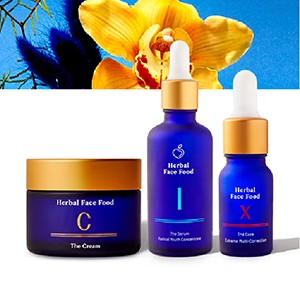There are a million lenses through which to view wellness. Ayurveda is one of them, but isn’t a philosophy we’ve delved into deeply enough on TCM. Whenever we encounter ayurvedic principles – whether at a spa, in a book, or through a pro like Shrankhla Holecek below – we’re always deeply impressed with the layers of meaning and balanced approach to care for mind and body.
Shrankhla is the creator of Uma Oils, a small line of highly functional, super-sexy beauty and wellness oils based in the ayurvedic tradition. We stumbled across her products at the Detox Market here in L.A and were so impressed with Shrankhla’s wisdom and the quality of these sustainable oils that we asked her to share a series of stories with us on ayurveda as it addresses a few common life issues. The first is anxiety. Check out her insights as well as her Pure Calm Wellness Oil (the most luxurious way to fight stress, we’re sure).
Ayurveda is a system of natural medicine that originated in India over 5000 years ago. It encompasses not only science but also philosophy, whereby the whole of life’s journey is considered sacred. Ayurveda draws on a system of scientific and practical knowledge, which is rooted in the ancient belief systems about the constitution of the human body, and its close relationship with the environment it exists in.
Within the practice of Ayurveda, all matter is believed to be made up of five elements: Prithvi (Earth), Agni (Fire), Jal (Water), Vayu (Air) and Aakash (Ether). They manifest in the human body as three basic principles: Vata (Ether and Air), Pitta (Fire and Water) and Kapha (Earth and Water). These three principles – vata-pitta-kapha – govern all the biological, psychological and physiopathological functions of body and mind. Disease and bodily discomfort is considered to be created from an imbalance in these principles.
Specific to anxiety:
Ayurveda, which takes a comprehensive view of an individual’s physical and emotional conditions, attributes anxiety to aggravated Prana-Vata, a subsidiary of Vata dosha which is associated with worry, anxiety & depression. Prana-Vata weakens the nervous system and creates imbalance in the emotional system. It is also believed to weaken the neuro-hormonal system & nerve impulses.
Ayurvedic treatment of anxiety involves curbing aggravated Prana-Vata by creating a more stable mental state through self-realization, and appropriate changes in diet & lifestyle.
Ayurveda is a lifestyle and a journey. In this article we will discuss some practical Ayurveda-based techniques to manage anxiety, but it is important to point out two important facts before we do. Ayurveda takes a very individual approach to elimination of disease, and we would encourage you to understand your individual constitution deeper as you explore this practice to find solutions even more customized and powerful. Second, Ayurveda teaching emphasizes the importance of elimination of toxins responsible for the disease (in the case of anxiety, ‘repressed emotion’ is the most common ‘toxin’) prior to its treatment. We encourage you to practice ‘release’ as you start to integrate these Ayurvedic solutions into your lifestyle for management of anxiety.
Lifestyle
Routine is considered very important to individual health within Ayurveda. Waking before sunrise is encouraged, as is morning exercise, breakfast before eight, lunch before noon and dinner before sundown. Additional lifestyle additions to create balance in the elements are: drinking warm water in the morning, cleaning the tongue, and oil massages prior to the morning shower.
Diet
Since anxiety is believed to be caused by excessive Prana Vata, foods that normalize the vata element in the body are encouraged. Some of the encouraged foods include Berries, Avocado, Bananas, Coconut, Cooked Vegetables, Asparagus, Cucumber, Zucchini, Oats (cooked), Rice and Wheat. Foods such as dried fruits, apples, cranberries, pears, broccoli, brussel sprouts, cabbage, eggplant, mushrooms, peppers, potatoes, barley. Buckwheat and corn aggravate the vata element and should be avoided.
Yoga
Ayurveda and Yoga are often considered sister sciences, in part because of their focus on holistic equilibrium of the mind and body. Yoga, and specific asanas within its practice, can have a powerful impact on normalizing the vata, and reducing anxiety. Shoulder stand, Cobra, Half Bow are particularly recommended for those experiencing anxiety and hypertension. In addition, Backward bends, head stands and plough poses are also very helpful for those that can integrate these slightly more advanced asanas in their practice.
Meditation and Pranayama
Breathing exercises (termed pranayama within yoga) rapidly help create balance within the mind and body. Just as in Yoga, there are various kinds of paranayama techniques, and for anxiety, “alternate nostril breathing” is most recommended. Just as it sounds, use your thumb to close one of your nasal passages while inhaling and exhaling deeply from the other, exercising deep, slow breathing. Repeat on the other side.
Natural Remedies
Ayurveda integrates the use of many natural herbs and “kitchen” remedies to manage anxiety and its symptoms. Specifically, topical application and inhalation of essential oils such as Vetiver, Roman Chamomile, Jasmine and Lavender can have rapid and lasting impact on the elimination of anxiety (try Uma’s Pure Calm blend that integrates all of these oils in a generations-old tried and true formula for anxiety relief). In addition, drinking a cup of milk with almonds, saffron & honey or Orange juice with honey & pinch of nutmeg powder will have powerful impact on the neutralization of anxiety.
Side note on understanding Ayurveda from a Western perspective
Western medicine often relies on the rule of numbers to cure, in that what is common to a majority of people constitutes the norm, and hence has universal applicability. Ayurveda dictates that every human constitution has its own particular and spontaneous temperament and functioning, and hence must be evaluated individually. The key to understanding one’s own or another’s constitution is often acceptance, observation and experience. Traditional medicine primarily relies on questioning, analysis and logical deduction – which may explain why it is sometimes difficult for practitioners of traditional medicine to comprehend the methodology of Ayurveda.
A core teaching in Ayurveda is to go beyond the division between subjectivity and objectivity, and to embrace practical experience, while getting connected deeper with our bodies and understanding our individual constitutions. Some questions, while inevitable, are not always answerable by anything but practical experience of relief. Even within western medicine, some questions are not fully understood. Antibiotics are used to kill bacteria that create toxins in the body, even though no adequate explanation exists as to why and how toxins are formed from bacteria. Ayurveda is truly a holistic science, in which the sum of its many elements comprises its truth. Early practitioners may sometimes need to briefly suspend disbelief and accept some departure from accepted norm, while trusting the practical relief their bodies are experiencing, from the integration of this powerful, ancient form of natural healing into their regiment.













